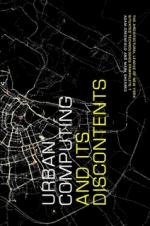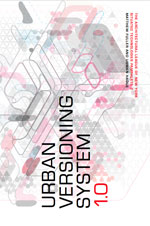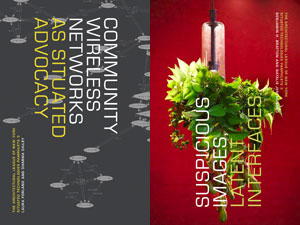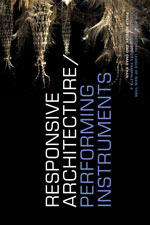Volume 16: Engineering Society & Volume 17: Content Management (2008)
Filed under magazine | Tags: · architecture, city, content management, publishing, urbanism

Volume 16: Engineering Society (2008, 2)
Just as there was a time before the book, there will also be a time after it. In this issue ‘The Last Book’ project is taken up, but as to the consequences of publishing exclusively online – the loss of filters such as the publisher, editor and publication costs – we can only guess. Yet it is clear that our centuries old house of knowledge is undergoing a fundamental renovation, beginning with the solid base of the library.

Volume 17: Content Management (2008, 3)
At the close of this era of expansion and surplus Volume speculates on one of the period’s emblematic inventions: Content Management, or the collecting, organizing and sharing of digital information. Our retrospective appraisal of recent developments in the managing of information offers inside into the ability of Content Management to serve the current realities of digital abundance and material shortage, and to protect both vast and extremely limited quantities.
Publisher Archis Publishers, Amsterdam
PDF (Vol. 16, added on 2013-7-28)
PDF (Vol. 17, added on 2013-7-28)
Andrew Benjamin, Charles Rice (eds.): Walter Benjamin and the Architecture of Modernity (2009)
Filed under book | Tags: · architecture, city, modernity, urbanism

Walter Benjamin is universally recognized as one of the key thinkers of modernity: his writings on politics, language, literature, media, theology and law have had an incalculable influence on contemporary thought. Yet the problem of architecture in and for Benjamin’s work remains relatively underexamined. Does Benjamin’s project have an architecture and, if so, how does this architecture affect the explicit propositions that he offers us? In what ways are Benjamin’s writings centrally caught up with architectural concerns, from the redevelopment of major urban centres to the movements that individuals can make within the new spaces of modern cities? How can Benjamin’s theses help us to understand the secret architectures of the present? This volume takes up the architectural challenge in a number of innovative ways, collecting essays by both well-known and emerging scholars on time in cinema, the problem of kitsch, the design of graves and tombs, the orders of road-signs, childhood experience in modern cities, and much more. Engaged, interdisciplinary, bristling with insights, the essays in this collection will constitute an indispensable supplement to the work of Walter Benjamin, as well as providing a guide to some of the obscurities of our own present.
Publisher re.press, Melbourne, July 2009
Anamnesis series
Creative Commons BY-NC-ND 2.5 license
ISBN 9780980544022
224 pages
The Situated Technologies Pamphlets 1-4 (2007-2009)
Filed under pamphlet | Tags: · architecture, city, interactive design, labour, life, situated technologies, ubiquitous computing, urban computing, urbanism
The Situated Technologies Pamphlet Series extends a discourse initiated in the summer of 2006 by a three-month-long discussion on the Institute for Distributed Creativity (iDC) mailing list, which culminated in the Architecture and Situated Technologies symposium at the Urban Center and Eyebeam in New York that October, co-produced by the Center for Virtual Architecture, the Architectural League of New York, and the iDC.
The series aims to explore the implications of ubiquitous computing for architecture and urbanism: How are our experience of the city and the choices we make in it affected by mobile communications, pervasive media, ambient informatics, and other “situated” technologies? How will the ability to design increasingly responsive environments alter the ways we conceive of space? What do architects need to know about urban computing, and what do technologists need to know about cities? How are these issues themselves situated within larger social, cultural, environmental, and political concerns?
Published three times a year over three years, the series is structured as a succession of nine “conversations” between researchers, writers and other practitioners of architecture, art, philosophy of technology, comparative media study, performance studies, and engineering. It takes on the urgent and ambitious task of exploring the implications of emerging technologies and their intersection with daily life.
Such a rapid insertion of texts into discourse is rarely witnessed within the context of traditional US publishing, which often requires years to go from manuscript to distribution of the printed book. We feel strongly that the discussion about Situated Technologies cannot be postponed that long. At the same time, we acknowledge that the subject is itself a moving target, as these technologies continue to evolve rapidly. Given these considerations, we’ve opted to publish the series using Print On Demand (POD) technology. Widely used but still little known, this publishing technique allows fast turnaround of books that can be ordered through online bookstores and are indistinguishable from many books in your bookshelf.
Series Editors: Omar Khan, Trebor Scholz, Mark Shepard

Situated Technologies Pamphlet 1: Urban Computing and its Discontents
by Adam Greenfield and Mark Shepard
Fall 2007
A conversation between the authors providing an overview of the key issues, historical precedents, and contemporary approaches to designing situated technologies and inhabiting cities populated by them.
Download a PDF here or get a printed copy from Lulu.com.

Situated Technologies Pamphlet 2: Urban Versioning System 1.0
by Matthew Fuller and Usman Haque
Spring 2008
What lessons can architecture learn from software development, and more specifically, from the Free, Libre, and Open Source Software (FLOSS) movement? Written in the form of a quasi-license, Urban Versioning System 1.0 posits seven constraints that, if followed, will contribute to an open source urbanism that radically challenges the conventional ways in which cities are constructed.
Download a PDF here or get a printed copy from Lulu.com.

Situated Technologies Pamphlet 3: Situated Advocacy
Summer 2008
A special double issue featuring the essays:
Community Wireless Networks as Situated Advocacy
– Laura Forlano and Dharma Dailey
Suspicious Images, Latent Interfaces
– Benjamin Bratton and Natalie Jeremijenko
Advocacy is the act of arguing on behalf of a particular cause, idea or person, and addresses issues including self-advocacy, environmental protection, the rights of women, youth and minorities, social justice, the re-structured digital divide and political reform.
Situated Technologies Pamphlets 3: Situated Advocacy considers how situated technologies have been—or might be—mobilized toward changing and/or influencing social or political policies, practices, and beliefs. What new forms of advocacy are enabled by contemporary location-based or context-aware media and information systems? How might they lend tactical support to the process of managing information flows and disseminating strategic knowledge that influences individual behavior or opinion, corporate conduct or public policy and law?
Download a PDF here or get a printed copy from Lulu.com.

Situated Technologies Pamphlet 4: Responsive Architecture / Performing Instruments
by Philip Beesley and Omar Khan
Spring 2009
A new generation of architecture that responds to building occupants and environmental factors has embraced distributed technical systems as a means and end for developing more mutually enriching relationships between people, the space they inhabit, and the environment. This pamphlet discusses key qualities of “responsive” architecture as a performing instrument that is both mutable and contestable.
Download a PDF here or get a printed copy from Lulu.com.
Comment (0)
